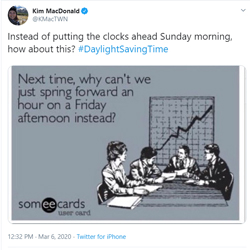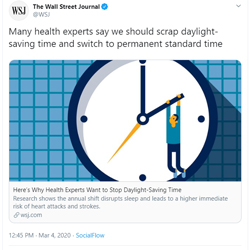NEW YORK—For many of us, this weekend is either the best of times or the worst of times. Or even a combination of the two. Why, you ask. It’s the weekend that we “spring ahead,” which means pushing the clock forward one hour and losing that hour of sleep from Saturday night into Sunday morning.
Yes, on Sunday, March 8, most Americans will turn their clocks forward one hour (does anyone still have an analog clock?) as Daylight Saving Time (DST) begins in the United States. (And, be advised, that it is incorrect to refer to this as daylight savings time – according to the grammar experts).

|
Many believe that these spring and fall clock changes continue a tradition started by Benjamin Franklin, who saw this exercise as a way to conserve energy. But others say Franklin is erroneously credited with this tradition, as you can read here on the Franklin Institute website. “Daylight saving time is one thing that Franklin did not invent,” the Franklin Institute notes. “He merely suggested Parisians change their sleep schedules to save money on candles and lamp oil.” At the time, Franklin was ambassador to Paris and so wrote a witty letter to the Journal of Paris in 1784, rejoicing over his "discovery" that the sun provides light as soon as it rises.
Historically, daylight saving time (DST) has begun in the summer months and ended right before winter, though the dates have changed over time as the U.S. government has passed new statutes. As of 2007, though, DST begins in the United States on the second Sunday in March, when people move their clocks forward an hour at 2 a.m. local standard time (so at 2 a.m. on that day, the clocks will then read 3 a.m. local daylight time). Daylight saving time then ends on the first Sunday in November, when clocks are moved back an hour at 2 a.m. local daylight time (so they will then read 1 a.m. local standard time).
Here are eight other things that you may not know about DST:
1. DST first began in May 1916 when Germany established the practice as a way to conserve fuel during World War I. The rest of Europe came onboard shortly thereafter. And in 1918, the United States adopted daylight saving time, according to the website Live Science.
2. President Woodrow Wilson wanted to keep DST after WWI ended, but at that time the country was mostly rural and farmers objected, partly because it would mean they lost an hour of morning light. And so DST was abolished until it came back into vogue with WWII.
3. Most of the United States and Canada observe DST on the same dates with a few exceptions. Hawaii and Arizona are the two U.S. states that don't observe daylight saving time, though Navajo Nation, in northeastern Arizona, does follow DST, according to NASA.
4. Fewer than 40% of the world's countries observe daylight saving time, according to timeanddate.com. However, those who do observe DST take advantage of the natural daylight in the summer evenings. That's because the days start to get longer as Earth moves from the winter season to spring and summer, with the longest day of the year on the summer solstice. During the summer season in each hemisphere, Earth, which revolves around its axis at an angle, is tilted directly toward the sun.

|
5. Turns out, people tend to have more heart attacks on the Monday following the "spring forward" switch to daylight saving time. Researchers reporting in 2014 in the journal Open Heart, found that heart attacks increased 24% on that Monday, compared with the daily average number for the weeks surrounding the start of DST.
6. Regions farthest away from the equator and closer to the poles get the most benefit from the DST clock change, because there is a more dramatic change in sunlight throughout the seasons.
7. Research has also suggested that with more daylight in the evenings, there are fewer traffic accidents, as there are fewer cars on the road when it's dark outside. More daylight also could mean more outdoor exercise (or exercise at all) for full-time workers.
8. During the Arab oil embargo, when Arab members of the Organization of Petroleum Exporting Countries (OPEC) stopped selling petroleum to the United States, Congress even enacted a trial period of year-round daylight saving time in an attempt to save energy.